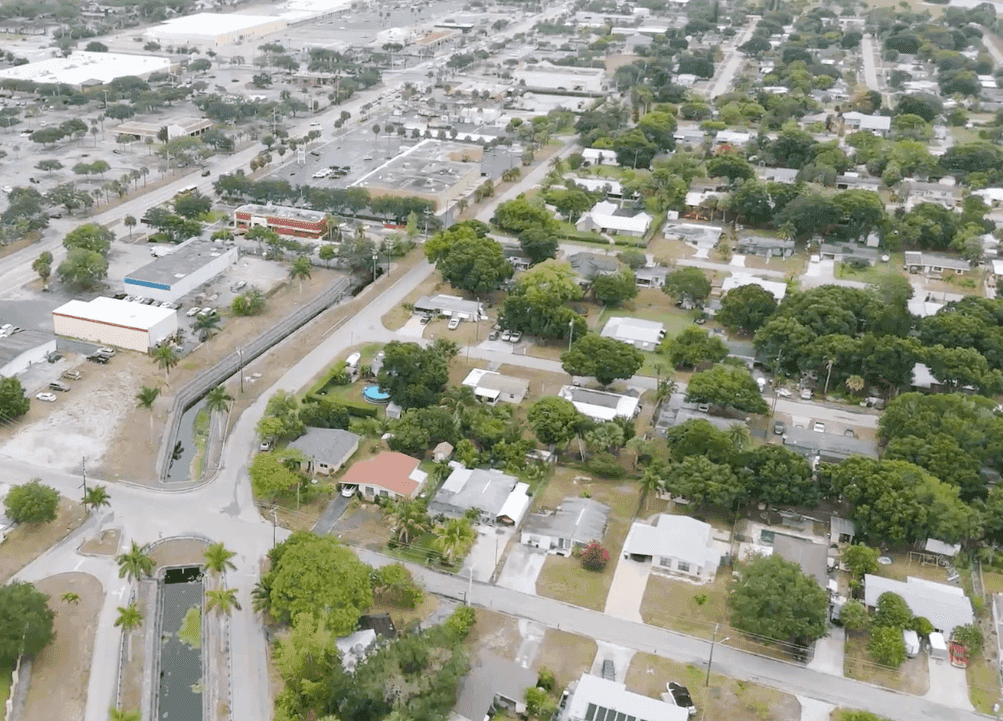
News
By Joseph Mendonca, November 19, 2024
Discriminatory land use policies, like urban renewal, restrictive lending, Euclidean zoning, and redlining, sabotaged wealth-building in Black and Brown communities, entrenched racial segregation, and institutionalized disinvestment in communities of color across the U.S. These inequities leave many Americans more vulnerable to the effects of climate change, meaning that increased flooding disproportionately impacts communities of color and further amplifies existing disparities.
Segregated into the floodplain
Land use policies have historically been used as a tool by institutions to further discrimination against Black and Brown communities across the U.S. Urban renewal, in which cities sought to clear “blighted areas” for new development, systematically targeted Black and Brown homes and businesses for demolition—often for the construction of highways that left communities divided, isolated, and polluted. This process destroyed Black and Brown wealth accumulation and displaced entire communities. Additionally, the process of “red-lining,” in which the Federal Housing Agency (FHA) labeled certain areas as “safe” or “unsafe” for lending mainly along racial lines, further entrenched segregation and limited opportunities for Black and Brown wealth-building.
In many cases, policies like these segregated communities of color into areas known to be susceptible to climate-related disasters. As many communities today remain segregated to various degrees, communities of color are disproportionately impacted by climate change and its effects. In places as far apart as Evanston, IL, Raleigh, NC, and Houston, TX, for example, low-lying areas were redlined by the FHA and remain occupied by people of color.
Located along the banks of the Tar River in Edgecombe County, North Carolina (where SGA worked as part of our Climate and Land Use Technical Assistance Program), the Town of Princeville has been devastated by repeated flooding. Floods caused by Hurricane Floyd in 1999 and Hurricane Matthew in 2016 were especially destructive, washing away much of the town. The devastation of these floods is tied to Princeville’s history. It was the first town in the U.S. founded by freed Black people after the Civil War. Denied access to develop in safer, higher-lying land, Princeville’s founders were forced to the swampy land on the Tar River’s south bank, which was known to flood. Although Princeville’s levee is supposed to protect it, structural damage in 1999 and 2016 caused it to fail. As of 2024, the levee still has not been repaired. Princeville’s story, unfortunately, is the story of many other communities of color across the Southeast and beyond.
Along Florida’s Gulf Coast, currently recovering from Hurricanes Helene and Milton, Black communities like Rubonia and North Port St. Joe were forced into low-lying areas along the coast due to redlining and other racist land use policies. Now, as tropical storms become increasingly common, they’re facing the worst effects of flooding—due both to their location and institutional disinvestment in their infrastructure.
Disinvested, then flooded
Redlining, urban renewal, and other racist land use policies that destroyed and segregated many communities of color also cut them off from the primary avenue of intergenerational wealth-building: real estate. With accumulated wealth in communities of color systematically dismantled and opportunities for growth and recovery repeatedly denied, Black and Brown families had little power to influence public or private sector decisions. This created a cycle of institutional disinvestment and impoverishment; governments and the private sector had little incentive to invest in these communities’ infrastructure, and residents had to face the consequences of those decisions.
For example, flood mitigation efforts have often prioritized wealthier and whiter communities, where property values are higher. For communities of color, like those in Baton Rouge, flooding-related infrastructure is crumbling. Even for cities further from the coast, like Detroit and Baltimore, the aging infrastructure that contains ghost streams, rivers, and wetlands (which were buried underground to provide more land for development) contribute to flooding problems in historically underserved neighborhoods. As a result, for many cities across the U.S., formerly redlined areas, where communities of color are often still located, are disproportionately vulnerable to flooding.




Because of these flooding disparities, communities of color deal with higher insurance rates and incur the costs of repeatedly rebuilding and repairing their homes. Since discriminatory land policies also stifle economic growth, worsen health inequities, and make communities of color more vulnerable to extreme heat, these communities continue to face additional and sometimes insurmountable barriers to intergenerational wealth-building.
Despite these challenges, communities can combat the legacy of racist land use policies. Smart growth strategies, like adjusting zoning codes, building green infrastructure, or boosting transportation resilience can help support flood-prone communities. In St. Lucie County, FL, for example, Smart Growth America partnered with community-based organization Incubate Neighborhood Center to produce a video highlighting some of the flooding issues that residents experienced—and how local policymakers can better support vulnerable community members.
Related News

© 2025 Smart Growth America. All rights reserved
Site By3Lane Marketing
















